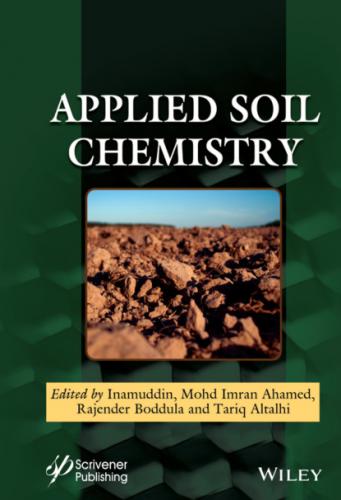2.3.2.6 Influence of Time on the Rate of Chemical Weathering
According Jackson et al., in the year 1948 [37], it was reported that for a particular particle size range and mineral species, the stages of weathering of the colloid weathering are the result of time duration of weathering and intensity function multiplication. Thorp et al., in the year 1944 [108], reported that soils present in some of the mountain displayed considerable development of soil and weathering after a particular duration of time. Retzer et al., in the year 1949 [63], reported great significance of the age of the mineral weathering and formation of dense, unique subsoils which are oftenly highly thick in case of Rocky Mountains of Central Colorado. The time of exposure or age exhibits crucial part for determining the type of mineral existing at a particular time in tropical soils. Mohr et al., in the year 1944 [96], reported five stages of weathering for the development of tropical soils. The stages include the following:
Beginning stage (unweathered virgin material)
Juvenile stage (point where there is beginning of weathering)
Virile stage (in this stage, the weathering is in highly advanced stage where the percentage of unweathered material is negligible)
Senile stage (at this point, there is completion of unweathered material weathering)
Final or end stage (at this point, development has reached to completion and the soil has been weathered.)
The above proposal displays that the weathering of mineral which contributes in formation of soil remains in equilibrium (dynamic) with the factors prevailing in the environment. According to the above proposal, at the final stage, there is the establishment of static equilibrium.
2.4 Conclusion
In this chapter, a brief summarization of process of chemical weathering and various factors like specific surface area, oxidation and reduction, biotic process, temperature, time, acidity, leaching, effect of water, etc., responsible for controlling the rate of chemical weathering is discussed.
References
1. Jackson, M.L. and Donald Sherman, G., Chemical weathering of minerals in soils, in: Advances in agronomy, vol. 5, pp. 219–318, Academic Press, Cambridge, Massachusetts, 1953.
2. Ruxton, B.P., Measures of the degree of chemical weathering of rocks. J. Geol., 76, 5, 518–527, 1968.
3. Reiche, P., Graphic representation of chemical weathering. J. Sediment. Res., 13, 2, 58–68, 1943.
4. Parker, A., An index of weathering for silicate rocks. Geol. Mag., 107, 6, 501– 504, 1970.
5. Polynov, B.B., The Cycle of Weathering, translated from the Russian by A, in: Muir, with a foreword by WG Ogg, Thomas Murby, London, 1937.
6. Mill, H.R., Geography: principles and progress, in: The international geography, pp. 2–13, 1899.
7. Polynov, B.B., Types of weathering crust, in: Transactions of the Third International Congress of Soil Science, Oxford, England, vol. 1, pp. 327–330, 1935.
8. Reiche, P., A survey of weathering processes and products, Univ. New Mexico Geol. Publ. No. 3, New Mexico, 1950.
9. Keller, W.D., The principles of chemical weathering. LWW, 80, 2, 165, 1955.
10. Goldich, S.S., A study in rock-weathering. J. Geol., 46, 1, 17–58, 1938.
11. Blackwelder, E., The insolation hyphothesis of rock weathering. Am. J. Sci., 152, 97–113, 1933.
12. Griggs, D.T., The factor of fatigue in rock exfoliation. J. Geol., 44, 7, 783–796, 1936.
13. Humbert, R.P. and Marshall, C.E., Mineralogical and chemical studies of soil formation from acid and basic igneous rocks in Missouri, University of Missouri, College of Agriculture, Agricultural Experiment Station, Missouri, 1943.
14. Cady, J.G., Rock weathering and soil formation in the North Carolina Piedmont region, in: Soil Sci. Soc. Am. Proc, vol. 15, pp. 337–342, 1950.
15. Allen, V.T., Weathering and heavy minerals. J. Sediment. Res., 18, 1, 38–42, 1948.
16. Kellogg, C.E., The soils that support us, vol. 52, no. 5, LWW, Philadelphia, 1941.
17. Shepard, W., Food or famine: the challenge of erosion, in: Food or famine: the challenge of erosion.
18. Gustafson, A.F., Conservation of the Soil, McGraw-Hill Book Company, Inc., New York, 1937.
19. Bowen, N.L., The reaction principle in petrogenesis. J. Geol., 30, 3, 177–198, 1922.
20. Morey, G.W., Experimental geology. J. Phys. Chem., 60, 6, 718–724, 1956.
21. Ito, K.E., II and Kennedy, J.C., Experimental study of basalt–garnet granulite–eclogite. Geokhimiya, 10, 4, 415–427, 1972.
22. Higgins, M.W., The geology of the Brevard lineament near Atlanta, Georgia. No. 77, Georgia State Division of Conservation, Department of Mines, Mining and Geology, Georgia, 1966.
23. Reed Jr., J.C., Bryant, B., Myers, W.B., The Brevard zone: A reinterpretation, in: Studies in Appalachian Geology: Central and Southern, pp. 261–269, Interscience, New York, 1970.
24. Crawford, T.J. and Medlin, J.H., The western Georgia Piedmont between the Cartersville and Brevard fault zones. Am. J. Sci., 273, 8, 712–722, 1973.
25. Shand, S.J., The terminology of late-magmatic and post-magmatic processes. J. Geol., 52, 5, 342–350, 1944.
26. Visher, S.S., Geologists Starred, 1903-43: Where Educated, Age. J. Geol., 53, 5, 326–336, 1945.
27. Chhibber, H.L., Origin of the bauxite deposits of India. J. Sci. Ind. Res., Delhi, 5, 4, 48–51, 1946.
28. Pettijohn, F.J., Persistence of heavy minerals and geologic age. J. Geol., 49, 6, 610–625, 1941.
29. Dryden, A.L. and Dryden, C., Comparative rates of weathering of some common heavy minerals. J. Sediment. Res., 16, 3, 91–96, 1946.
30. Morton, A.C., Stability of detrital heavy minerals in Tertiary sandstones from the North Sea Basin. Clay Miner., 19, 3, 287–308, 1984.
31. Goldich, S.S., A study in rock-weathering. J. Geol., 46, 1, 17–58, 1938.
32. Wolf, A., Weathering of the Medford Diabase: Pre-or Postglacial? J. Geol., 40, 5, 459–465, 1932.
33. Velbel, M.A., Geochemical mass balances and weathering rates in forested watersheds of the southern Blue Ridge. Am. J. Sci., 285, 10, 904– 930, 1985.
34. Van Der Marel, H.W., Tropical soils in relation to plant nutrition. Soil Sci., 64, 6, 445–452, 1947.
35. Van der Marel, H.W., Gamma ferric oxide in sediments. J. Sediment. Res., 21, 1, 12–21, 1951.
36. Van Der Marel, H.W., Quantitative differential thermal analy ses of clay and other minerals. Am. Min.: Journal of Earth and Planetary Materials, 41, 3–4, 222–244, 1956.
37. Jackson,
